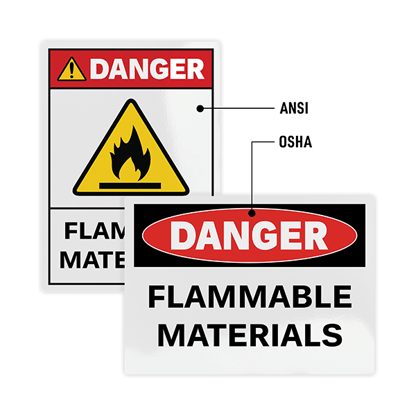If you work in an industrial facility, you know that OSHA and ANSI are two terms often connected to safety sign discussions. Especially safety sign standards and compliance. Some operations and facility managers may even inadvertently use the two terms interchangeably.
While both OSHA and ANSI safety sign standards aim to protect workers from hazards in the workplace, they are completely different in a few key areas. Failing to understand the nuances between OSHA vs ANSI safety signs increases your chances of an OSHA citation on inspection day.
What is the American National Standards Institute (ANSI)?
The American National Standards Institute (ANSI) is a non-profit organization dedicated to fostering global competitiveness in US companies and improving the quality of life for Americans. For over 100 years, ANSI has led the way in helping establish voluntary consensus for standards that protect the safety and health of consumers, workers and the environment.
Conversely, the Occupational Safety and Health Administration (OSHA) is a US government agency that sets and enforces standards for health and safety. Although ANSI and OSHA are often mentioned together in regard to safety sign compliance, it’s important to understand that ANSI is not a government agency. It does not have the legal power to enforce or set standards for safety signs.
So what does ANSI do? ANSI accredits standards developed by others. ANSI accreditation employs due process procedures to ensure unbiased, fair treatment of the standards being evaluated. This establishes voluntary consensus, which simply means professionals in the private and public sector all agree on the standards, following them is completely voluntary— almost.
How ANSI and OSHA Work Together
While ANSI safety sign standards (and ANSI standards in general) are voluntary, ANSI accreditation often directly influences mandatory OSHA regulations in three critical ways. Firstly, ANSI standards may be adopted by OSHA. Secondly, OSHA may cite specific ANSI standards in an OSHA regulation. Lastly, (and most ambiguously) ANSI standards are considered “generally recognized” by OSHA and can be referred to in instances where failure to communicate a hazard resulted in injury, illness or death.
OSHA Adoption of ANSI Safety Sign Standards
ANSI accreditation of safety sign standards developed over time are the basis of many safety sign standards enforced by OSHA in 2019. In fact, when OSHA was created in 1971, its mandatory Hazard safety sign regulations could be traced through ANSI to before the First World War.
In 1914, the Worker’s Compensation Bureau published the first pamphlet making suggestions regarding safety signs in the workplace. These standards were developed over time, and in 1941 ANSI (then called the American Standards Association) published the first accredited guidelines for safety sign meanings, design and formatting. These in turn were used for the basis of OSHA safety sign regulations at its formation.
OSHA may also adopt ANSI guidelines as mandatory at any time. For example, in 2002 ANSI began including symbols to enhance safety signs meanings. A 2013 OSHA safety signage ruling integrated ANSI Z535.1-2006(R2011), Z535.2-2011 and Z535.5-2011 into its standards relating to safety signs, giving employers the option to comply with any version of the ANSI Z535-2011 standard.
When an OSHA Regulation Cites an ANSI Standard
ANSI standards can become mandatory through something called “incorporation by reference.” Which is the term for when a mandatory OSHA regulation cites a voluntary ANSI standard, making it mandatory by proxy. In these cases, failure to follow the ANSI standard will result in a citation from OSHA.
Examples of ANSI standards that are incorporated by reference into OSHA regulations include ANSI Z35.1-1968, which outlines specifications for safety signs to prevent accidents, and ANSI Z535.2-2011, which concerns environmental and facility safety signs.
OSHA and ANSI Color-Code Reference Guide
OSHA safety sign standard 1910.145 regulates safety signs and tags for accident prevention and makes some ANSI safety sign standards enforceable by law under the “incorporated by reference” rule. OSHA establishes three classes of safety signs: Danger, Caution and Instruction. Each class of safety sign has its own set of colors and specifies the nature of instances in which each type of sign should be used.
ANSI Z535.2-2011 (R2017) identifies two additional classes of safety signs: Warning and Notice which are not required by law. However, it is a good idea to use them when applicable in your facility. Incorporating ANSI warning signs and notice signs help you protect workers and cover yourself legally in case of an accident.
Danger Safety Signs
When hazards are present that constitute an immediate danger and special precautions are necessary, safety signs that immediately signal the severity of the situation should be used. Under OSHA regulation 1910.145(d)(2) Danger Signs must be in red, black and white, specifically citing ANSI standards Z53.1-1967 and Z535.1-2006(R2011) for further style references.

Caution Safety Signs
OSHA-compliant Caution Signs require a yellow background, a black header panel with yellow letters and only black letters are to be used on the yellow background per OSHA regulation 1910.145(d)(4). Caution safety signs are used to warn against potential hazards and/or unsafe practices. Additionally, ANSI Z53.1-1967 and Z535.1-2006(R2011) are to be consulted for further guidelines.
Safety Instruction Signs
OSHA regulation 1910.145(d)(6) Safety Instruction Signs should have a white background, and the panel should be green with white letters. Only black letters should be used on the white background. Like Danger Signs and Caution Signs, additional style guidelines for Safety Instruction Signs are referenced in ANSI ANSI Z53.1-1967 and Z535.1-2006(R2011).
Warning & Notice Safety Signs
Warning and Notice safety sign standards are outlined in ANSI Z535.2-2011 (R2017). Warning signs alert employees to hazardous situations between “danger” and “caution” in severity and should be designed with black letters on an orange background.
Notice safety signs are used for situations not directly related to personal injury, yet contributing to the overall safety and/or health of the employee. Instruction relating to security practices and sanitation measures are good examples of instances in which to use this particular safety sign.
OSHA/ANSI Safety Sign Inspection Tips
Choose Safety Signs that Function in Your Facility
The location and placement of safety signs is an important part of an effective HazCom program. In fact, OHSA 1910.145(f)(4)(vi) states that safety messaging (whether communicated by safety tags or safety signs), must be placed “as close as safely possible to their respective hazards.”
Adhesive safety signs are ideal for surfaces where other signs can’t effectively be used, such as glass or other surfaces where drilling holes may not be desired. However, it’s important to equip your facility with custom adhesive safety signs that are rigorously tested to withstand heavy-duty workspaces.
Protect your workers and set yourself up for a successful OSHA inspection by choosing self-adhesive safety signs that are made from durable polyester materials and are easy to keep well-maintained. Key features to look for in labels for indoor safety signage are water, chemical, abrasion and tear-resistance.
Be Prepared to Quickly Update Safety Signage
It’s always good to be prepared for last minute safety sign updates and quick changes to avoid repeat citations. Quality high-performance removable adhesive signs that you can print on site are ideal for making quick and/or temporary safety sign updates in your facility.
Onsite printable safety signs allow you to prepare and make updates quickly and easily whether inspection day is today or two weeks from today. The ability to print from your desktop laser or inkjet printer gives you the power to quickly and efficiently correct mistakes or continue preparation right up to the last minute.
Best Practices for Safety Sign Compliance
Choosing to implement ANSI safety sign standards throughout your facility (regardless of whether OSHA calls them out by name) is the best way to ensure compliance on inspection day. As ANSI safety signage guidelines are more comprehensive, following them demonstrates to OSHA you have taken all possible measures to communicate safety hazards in your facility.





